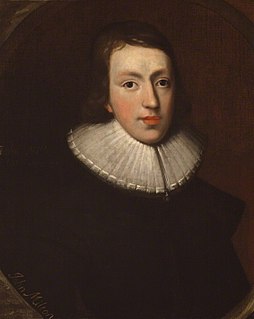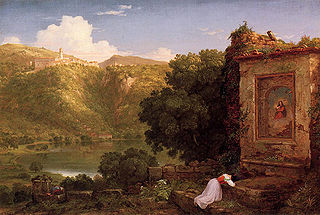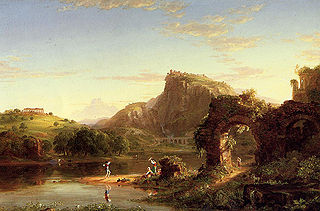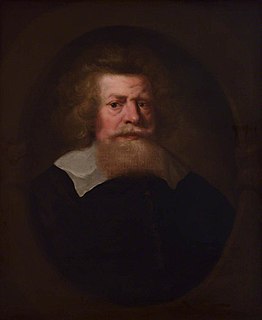Related Research Articles

John Milton was an English poet and intellectual who served as a civil servant for the Commonwealth of England under its Council of State and later under Oliver Cromwell. He wrote at a time of religious flux and political upheaval, and is best known for his epic poem Paradise Lost (1667). Written in blank verse, Paradise Lost is widely considered one of the greatest works of literature ever written.

Paradise Lost is an epic poem in blank verse by the 17th-century English poet John Milton (1608–1674). The first version, published in 1667, consists of ten books with over ten thousand lines of verse. A second edition followed in 1674, arranged into twelve books with minor revisions throughout. It is considered to be Milton's masterpiece, and it helped solidify his reputation as one of the greatest English poets of all time. The poem concerns the biblical story of the Fall of Man: the temptation of Adam and Eve by the fallen angel Satan and their expulsion from the Garden of Eden.

The term Metaphysical poets was coined by the critic Samuel Johnson to describe a loose group of 17th-century English poets whose work was characterised by the inventive use of conceits, and by a greater emphasis on the spoken rather than lyrical quality of their verse. These poets were not formally affiliated and few were highly regarded until 20th century attention established their importance.

Il Penseroso is a poem by John Milton, first found in the 1645/1646 quarto of verses The Poems of Mr. John Milton, both English and Latin, published by Humphrey Moseley. It was presented as a companion piece to L'Allegro, a vision of poetic mirth. The speaker of this reflective ode dispels "vain deluding Joys" from his mind in a ten-line prelude, before invoking "divinest Melancholy" to inspire his future verses. The melancholic mood is idealised by the speaker as a means by which to "attain / To something like prophetic strain," and for the central action of Il Penseroso – which, like L'Allegro, proceeds in couplets of iambic tetrameter – the speaker speculates about the poetic inspiration that would transpire if the imagined goddess of Melancholy he invokes were his Muse. The highly digressive style Milton employs in L'Allegro and Il Penseroso dually precludes any summary of the poems' dramatic action as it renders them interpretively ambiguous to critics. However, it can surely be said that the vision of poetic inspiration offered by the speaker of Il Penseroso is an allegorical exploration of a contemplative paradigm of poetic genre.
Tetrachordon was published by John Milton with his Colasterion on 4 March 1645. The title symbolizes Milton's attempt to connect four passages of Biblical Scripture to rationalize the legalization of divorce.

L'Allegro is a pastoral poem by John Milton published in his 1645 Poems. L'Allegro has from its first appearance been paired with the contrasting pastoral poem, Il Penseroso, which depicts a similar day spent in contemplation and thought.
The Doctrine and Discipline of Divorce: Restor'd to the Good of Both Sexes, From the Bondage of Canon Law was published by John Milton on 1 August 1643. An expanded second edition was published on 2 February 1644. The editions were published anonymously, and his name was not associated with the text until they were denounced before Parliament in August 1644. Milton's basic scriptural argument is that Christ did not abrogate the Mosaic permission for divorce found in Deuteronomy 24:1 because in Matthew 19 he was just addressing a specific audience of Pharisees.
Colasterion was published by John Milton with his Tetrachordon on 4 March 1645. The tract is a response to an anonymous pamphlet attacking the first edition of The Doctrine and Discipline of Divorce. Milton makes no new arguments, but harshly takes to task the "trivial author".
Judgement of Martin Bucer by John Milton was published on 15 July 1644. The work consists mostly of Milton's translations of pro-divorce arguments from Martin Bucer's De Regno Christi. By finding support for his views among orthodox writers, Milton hoped to sway the members of Parliament Protestant ministers who had condemned him.

William Dell was an English clergyman, Master of Gonville and Caius College, Cambridge from 1649 to 1660, and prominent radical Parliamentarian.

De Doctrina Christiana is a theological treatise of the English poet and thinker John Milton (1608–1674), containing a systematic exposition of his religious views. The Latin manuscript "De Doctrina" was found in 1823 and published in 1825. The authorship of the work is debatable. In favor of the theory of the non-authenticity of the text, comments are made both over its content, as well as since it is hard to imagine that such a complex text could be written by a blind person However, after nearly a century of interdisciplinary research, it is generally accepted that the manuscript belongs to Milton. The course of work on the manuscript, its fate after the death of the author, and the reasons for which it was not published during his lifetime are well established. The most common nowadays point of view on De Doctrina Christiana is to consider it as a theological commentary on poems.
Defension Secunda was a 1654 political tract by John Milton, a sequel to his Defensio pro Populo Anglicano. It is a defence of the Parliamentary regime, by then controlled by Oliver Cromwell; and also defense of his own reputation against a royalist tract published under the name Salmasius in 1652, and others criticism lodged against him.
Arcades is a masque written by John Milton and performed on 4 May 1634. The piece was written to celebrate the character of Alice Spencer, the Countess Dowager of Derby, widow of Ferdinando Stanley, 5th Earl of Derby, during her 75th birthday. The masque distinguishes Spencer as having a greater far superior to other noble women by titling Spencer as queen of a metaphorical Arcadia that is far superior to any other realm. The piece served as a basis for Milton's later masque, Comus.
A Treatise of Civil Power was published by John Milton in February 1659. The work argues over the definition and nature of heresy and free thought, and Milton tries to convince the new English Parliament to further his cause.
John Milton's antiprelatical tracts are a series of five political pamphlets that attack the episcopal form of church leadership.
The religious views of John Milton influenced many of his works focusing on the nature of religion and of the divine. He differed in important ways from the Calvinism with which he is associated, particularly concerning the doctrines of grace and predestination. The unusual nature of his own Protestant Christianity has been characterized as both Puritan and Independent.

John Milton wrote poetry during the English Renaissance. He was born on 9 December 1608 to John and Sara Milton. Only three of their children survived infancy. Anne was the oldest, John was the middle child, and Christopher was the youngest.
Politics were an important part of John Milton's life. Milton enjoyed little wide-scale early success, either in prose or poetry, until the production of his later, controversial political works starting with The Tenure of Kings and Magistrates and Eikonoklastes.

The poetic style of John Milton, also known as Miltonic verse, Miltonic epic, or Miltonic blank verse, was a highly influential poetic structure popularized by Milton. Although Milton wrote earlier poetry, his influence is largely grounded in his later poems: Paradise Lost, Paradise Regained, and Samson Agonistes.
James Heath (1629–1664?) was an English royalist historian.
References
- Garrison, John. “Plurality and Amicitia in Milton’s Epitaphium Damonis,” Milton Quarterly 46.3 (October 2012): 154-173.
- Henry, Nathaniel. "Milton and Hobbes: Mortalism and the Intermediate State," SP, Vol. 48 (1951): 234–249.
- Kerrigan, William; Rumrich, John; and Fallon, Stephen (eds.) The Complete Poetry and Essential Prose of John Milton. New York: The Modern Library, 2007.
- Lewalski, Barbara K. The Life of John Milton. Oxford: Blackwells Publishers, 2003.
- Miller, Leo. John Milton among the Polygamophiles. New York: Loewenthal Press, 1974.
- Milton, John. Complete Prose Works of John Milton Vol IV Ed. Don Wolfe. New Haven: Yale University Press, 1962.
- Nicolson, Marjorie Hope. "Milton and Hobbes," SP, XXII (1935): 553–579.
- Patterson, Annabel. "Milton, Marriage and Divorce" in A Companion to Milton. Ed. Thomas Corns. Oxford: Blackwell Publishing, 2003.
- Rumrich, John. "Radical Heterodoxy and Heresy" in A Companion to Milton. Ed. Thomas Corns. Oxford: Blackwell Publishing, 2003.
- Rosendale, Timothy. "Milton, Hobbes, and the Liturgical Subject" SEL 1500–1900. Vol. 44 No. 1 (2004).
- Springborg, Patricia. "Hobbes, Heresy, and the Historia Ecclesiastica". Journal of the History of Ideas, Vol. 55 No. 4 (Oct. 1994): 553–571
- Williamson, George. "Milton and the Mortalist Heresy," SP, XXII (1935): 553–579
